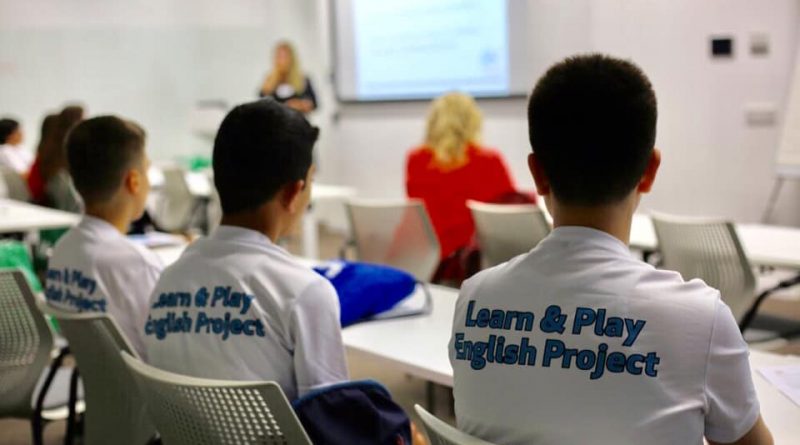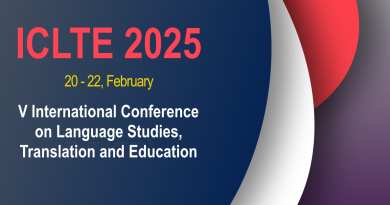Discussing Current Trends in Language Education
This post comes up to follow numerous discussions in social media and academic circles about language teaching nowadays, language teacher in the 21st century, and educational settings for language teaching and learning.
As educators we are trying to pace up with the modern needs and requirements, expectations of the institutions and learners. On this way we are learning by ourselves to keep up with the changing demands and technological enhancements.
The overview of the modern trends given below is an attempt to summarise current practices and calls for language teaching in the globalised context of education, institutions and individual practices which have already become a big stream rather than separate cases.
Technology-Enhanced Teaching and Learning
Speaking about the language education nowadays it is just inevitable to begin with the technology-enhanced teaching and learning. The topic is not new. Academicians and practitioners have been questioning and debating in this area for years already but the problem will not expire for even longer period of time due to the rapidly growing market of ICT, designed for language teaching, and the gap between the technological advances and the competences of the language teachers to apply technologies. The policies of the countries and institutions add to the discrepancies existing between the teaching practices in different educational settings. The technological supply at the place is not the last topic to speak about. If years ago we were speaking about a necessity of the access to Internet only to be able to join the mainstream of the technologies, but nowadays it is not the only solution.
Growing supply of technologies raises a need to be able to analyse the value of new tools, their applicability to the educational and cultural settings, financial side of using the app, as well as the methods of implementing them not to overburden the teaching but to facilitate learning.
Growing supply of technologies raises a need to be able to analyse the value of new tools, their applicability to the educational and cultural settings, financial side of using the apps, as well as the methods of implementing them not to overburden the teaching but to facilitate learning.
Being overwhelmed with technological offers teachers and institutions sometimes choose the methods and ICT they have already used to apply, not willing to open immediately for new technological enhancements, considering time for learning new tools and financial side of the question. If we say, our students are very much open for new technologies, it is not so too. In their learning they follow the way they have used to take up in their schools and drastically new changes are taken with precautions.
So To Be or not To Be? Of course, To Be, but with the great amount of critical thinking, readiness for new challenges, foreseeing ups and downs, and trying to manage the educational process according to the actual aims and targets of our language learners.
Personalised Tutoring and Language Delivery
Growing life tempo, economical changes and political processes make people to stay in a rat race to pace up with employers’ demands. Nowadays another language is a must wether we are studying, being employed or looking for new job. To apply for the language program in the official institution, to devote hours to sitting at the desk and learning in the classroom with the students who are much more different from your level and strivings become already a waste of time. Adult students are looking for more dynamic and effective ways – to spend less time but to get more and precisely to their aims. That is why the language tutoring offer and demand are at high rate.
Convenient time, personalised program, adjustability to the working schedule, responsiveness, meeting the actual language needs are all the features our adult students are looking for and cannot find in the official settings of the institution or the language school.
Convenient time, personalised program, adjustability to the working schedule, responsiveness, meeting the actual language needs are all the features our adult students are looking for and cannot find in the official settings of the institution or the language school. Don’t also forget expenses for the travelling and life establishing if we think about taking a language course in the other country or even a city. Immediate connection with Skype or other available tool provides direct access to the native speakers, professional language instructors no matter where they are located.
The question here is about teaching methods and contents to design to meet our adult students’ expectations.
Language for Professional Needs
Looking for a new job? Yes, please, but be ready to demonstrate enough language competences to cope with the job tasks and assignments. In this case language learners do not need extended knowledge of grammar and structures, maybe even the vocabulary can be limited, needed as much as the person can cope with the communicative situations at the job setting. Yes, the problem is not new, we have been delivering courses of English for Specific Purposes for years, but the matter is that new jobs at the market are evolving much more faster than the institutions can develop programs, authorise them and get the confirmation from the Ministry of Education and other governing establishments for the permission to renew the curricula and deliver it to the students. To find a solution we address to the language tutors, dynamic educational establishments which are able to respond immediately to the changes and demands.
Language teachers are expected to design such courses and contents which would cover the job area in terms of the vocabulary and the actual language structures needed for communication.
In this case the language teachers are expected to design such courses and contents which would cover the job area in terms of the vocabulary and the actual language structures needed for communication. It means the language teachers should have an idea about jobs, their environments, assignments and the communicative challenges the students might face when entering the position.
Inclusiveness and Teaching Language for Special Education
Inclusive education is another huge area for academicians and practitioners to think about and to send their endeavours. Life practice demonstrates that if educated with the proper methods the learners with special needs are able to pace up with life and employment. They are capable to learn another language as far as they have managed to learn their native language. Special needs differ a lot in their nature and origin, but by adjusting the educational contents, methods, environments, providing proper social support and opportunities for social practices we can enhance significantly their learning outcomes and facilitate their inclusion into life and working settings.
Adjusting the educational contents, methods, environments, and providing proper social support and opportunities for social practices we can significantly enhance learning outcomes of the students with special needs.
Depending upon the nature of the special needs we have to develop curricula, overlook the teaching methods, redesign the programs, considering that all current language books and learning materials issued are aiming the students with the average skills and capabilities. Language technologies here are in help, but their supply still does not seem enough to cover all cases. At least they have not yet entered the wide practice of the special education teachers and institutions.
Language for Refugee Assimilation
Migration waves have never been as powerful and numerous as during last years. Moved by wars, political and economical crisis, individuals, families and whole nations have been looking for a shelter in other countries. Needless to say that migration is accompanied with losses, trauma, needs and hopes to find a better destiny and to settle life in a protected environment.
Speaking about migrants’ assimilation in the other country the problem of language and culture comes up the first. Together with the language problem migrants face a difficulty to accommodate their qualifications to the new working environments.
Not entering the details about the specifics of the migrants status in a foreign country we just need to state that they require differently designed programs and courses aimed not only to teach the language, but to show the ways how to adjust to the culture of the language, and how to deal in the working environments considering cultural differences, law peculiarities and traditional ways of communicating in the targeted society. The programs should take into account the cultural background of the newcomers, their mother language specifics, special conditions of their stay in a foreign country (e.g. financial difficulties, absence of the basic required competences for technology, literacy, etc, psychological trauma, a need to earn for living, etc). Multiple Massive Open Online Courses have been designed for the refugees to cope with the language problems and gain new qualifications to get employed, though the problem of the teaching contents, teaching methods and learning materials remain to be under discussion.
Language for Young Learners
Teaching language to children is another area where we should think deeply and carefully.
Nowadays more and more parents realise a necessity for their children to learn foreign languages in yearly years. Some of them see it as the only reliable way to guarantee future success in life and work. No need to mention that exposure to other languages in childhood significantly broadens cognitive abilities of the students, their flexibility and adjustability to the changing environments.
I may sound contrary to the last tendencies but I would urge teaching language to kids in a more social way rather than relying on technologies. They are already addicted to phones and games as the statistics states all over the world.
We need to bring them to the real life, because language is a tool of a human being as a social creature, a tool to interact and communicate. We need to address to their inner creativity and curiosity, to reveal their talents and inclinations, to give a way for feeling, acting and decision making. It is a way for self-realisation and discovery by playing, manipulating, creating and interacting with the community.
Very many children have already forgotten or have never experienced how to draw, to make things with scissors, to create anything by themselves. Everything given ready in apps invalid our children, depriving them from their real nature, blocking their inner selves. Language is a way to interact in the society, and that is what we should teach them.
New language should be an environment created, where children play, solve problems, find solutions, help and share. It is not an aim to reach, it is a tool to develop in order to equip our children for social well-being and to open doors for future.
Language learning context is the most favourable for engagement, creativity, communication and interaction. Taking into account this belief we can design much more effective language programs encouraging children’s talents to open, and to grow the kids into self-confident social beings.
Teaching Language in Multicultural Classrooms
The problem of teaching languages in multicultural classrooms in closely connected with the migration raise. In this context we should stress the teachers’ competences needed to manage the classroom and the program delivery.
First of all that is the awareness of the cultural diversity considering not only national background of the students, but also the ways they used to study, specifics of behaviours and communication.
The teacher may experience resistance to the teaching methods applied, non-cooperative ways of behaviour due to the cultural and religious restrictions, margining of some students by the classroom community, problems of communication and understanding.
Bearing the problems in mind the teachers have to posses knowledge about the cultures represented in the classroom, raise awareness of the students about cultural diversity, empathy and cooperative behaviours.
The special attention should be given to the topics and issues brought for learning and discussion in the classroom, highlighting the points which are similar for all cultures and giving value to different opinions and points of view.
Overstepping Borders of the Classroom
Following recent educational practices and students’ strivings we can state that learning cannot stay within the classroom walls any longer. Let it be in-weaving Internet resources into the curriculum and enlarging the scope of the topic taught with case studies from the outside, real-life examples, or changing the physical environment of the classroom for the real life settings to experiment with the language and gain new experiences, – whatever is at hand, all are useful for interiorising the language knowledge and providing more opportunities for practicing and interacting.
In this case project language education is at high stream nowadays, giving a way for more interactive and creative language learning.
Social Media as a Tool for Language Delivery and Practicing
it is already decades as social media tools have been occupying the primary position for communicating and sharing information. Thousands of case studies and publications provide evidence that social media has gained its firm status in learning, both official and non-official. Platforms of social media are reasonable substitutions for expensive language technological applications, giving opportunities for their users to practice language and master communicative tactics.
Despite enormous studies, the problem of the amount of the social media in the teaching process, evaluating the appropriateness of the social media tools, methods of effective usage of social media, cultural attitudes and perception of social media, styles and behaviours in social media environments are still under discussion and need special attention from the side of the language teachers and educators.
Learning Culture Rather than Language
“We want our children to learn a language, and not to get influenced by their culture”, sometimes we can hear such remarks from the parents in closed cultural communities.
The conflict of cultures and religions is a sensitive topic to speak about, at the same time to separate language from culture is extremely difficult. Language represents the culture and traditions of the community, speaking the language. it reflects its cultural realias, ways of behaviours, styles of communication. While teaching the language we should stress cultural peculiarities as for differences in communicative acts, such as greetings, conducting negotiations, discussing, conflict resolution, body language as a substitution of the language signs and meanings, etc. To know the language and being ignorant about cultural specifics of communication won’t last long without falls and failures in understanding.
Language Teacher as a Collaborator rather than Knowledge and Theories Deliverer
Coming across with the numerous posts and publications about the teacher of the 21 century, the demands spelled out, pictures strictly pointing if teachers are ready to teach in the 21 century, I start feeling sorry for our teachers. Facing this pressure and asking themselves if they are capable to cope with the challenges of the new era, at the same time being stuck within the limits of the funding scarcity, dependence upon the authorities and policies, struggling to meet the requirements for the professional development considering research and academic achievements, complying with the bureaucratic demands from the controlling organs, and threatened to be underestimated by the students – that is the reality of the teacher entering the 21 century… Most probably it is not a full list of problems our colleagues are experiencing in different schools and countries, but what can be stated for sure is that the expectations and demands with the scarcity of resources and support available for teachers tend to escalate.
Do they love their children if they cut funding for teaching?
Apart from the problems mentioned and coming back to the topic of our discussion the language teachers have to be able to compete at the market of the teaching services. To compete and to stay up we need to keep on with the professional development, raising our competences in the language we teach, methods we apply and technology we use. We should remember that it’s not the responsibility of one teacher only to provide qualitative teaching but it must be mutual efforts of the authorities, policies, cultures with the significant material support to teach respectively.
At the same time it is within the responsibility of the teachers to overlook the teaching methods, changing the teaching paradigm from the knowledge/theories delivery to the collaborative teaching, giving opportunities for the students for self-realisation, speaking out their experiences, sharing ideas, and constructing knowledge socially, by all participants contributing to the learning process.
Collaborative Language Teaching
The language teacher is not the only source for teaching and delivering knowledge. And not the only teacher in the course. The reasons are simple. The more our students are going to be exposed to various sources and situations, the more capable and flexible they are going to be in real communication. It is already a fact that when students are taught by one teacher, they get used to their manners of speaking, ways of interacting and responding, but when meeting other language speakers or coming into new communicative settings they lose the ability to understand and respond. Therefore, a team of teachers actively involved in the teaching process can be a much more effective way to raise students’ confidence to speak a new language and to collaborate in the international settings.
A team of teachers actively involved in the teaching process can be a much more effective way to raise students’ confidence to speak a new language and to collaborate in the international settings.
The question in this context is how to develop the contents and the programs to provide an exposure for the students to various language sources as well as for the language teachers to work in a team and collaborate effectively to reach the mutual aims.
Aiming Competences Rather than Diplomas
Language students need to demonstrate competences and skills to communicate effectively. Diplomas on the table are not the only solution any longer.
Graduating from the university or prestigious language school does not give you a guarantee for good employment.
Graduating from the university or prestigious language school does not give you a guarantee for good employment unless you are not able to take up responsibilities immediately and at full extent. International experience, creativity, effective collaboration in teams, responsiveness and flexibility are expected by the employers. Is it in hands of the language teacher? Partially yes, through providing opportunities for developing such skills during the language program and practicing the language.
Prof. Dr. Iryna Sekret, IATELS Committee Chair




